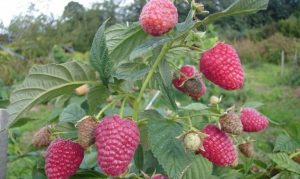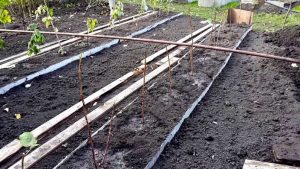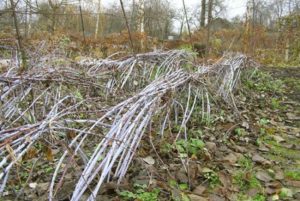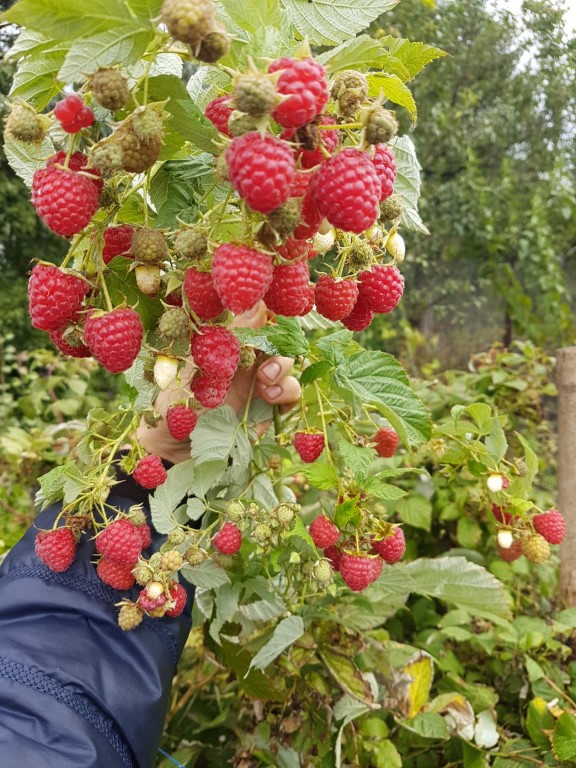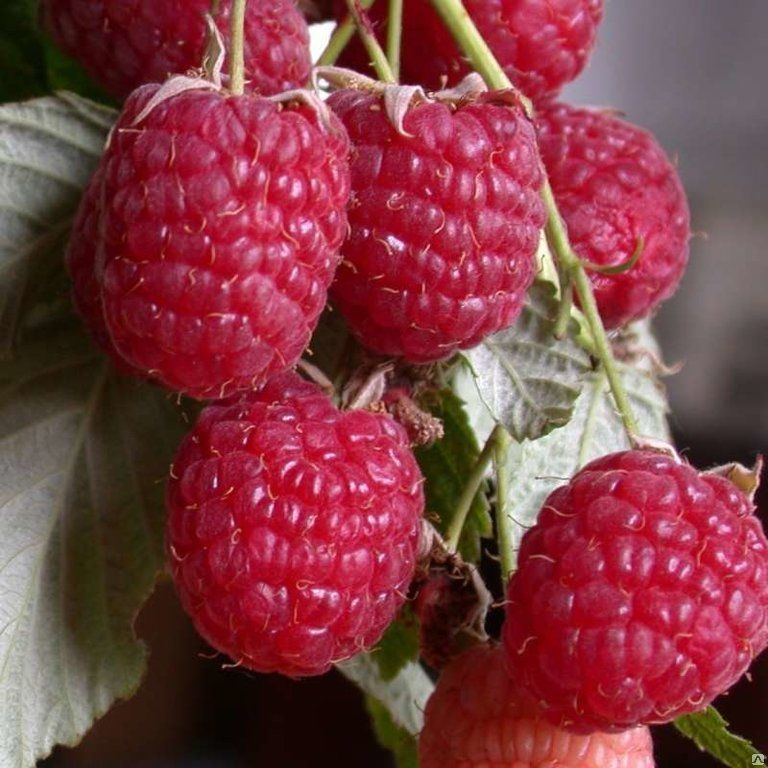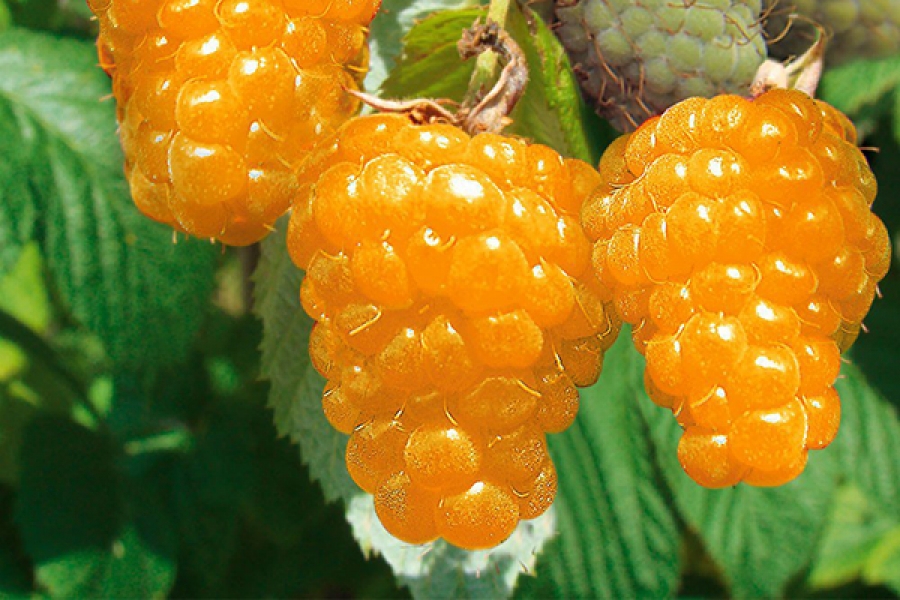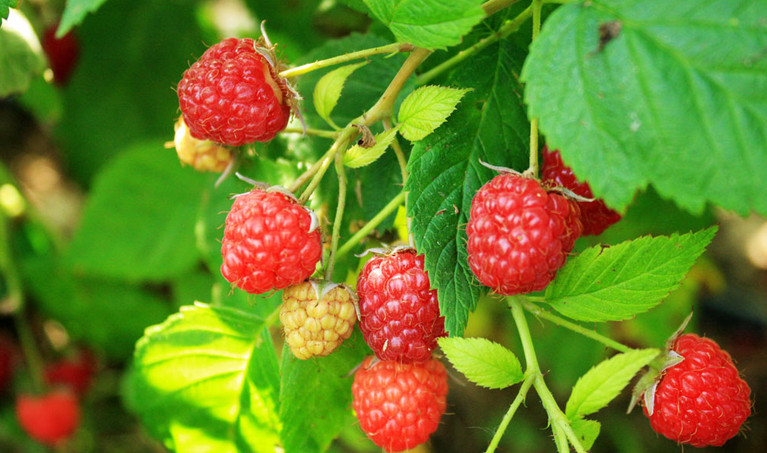Content:
A large, sweet, slightly sour berry and a generous harvest are just about raspberries Abundant domestic breeder Kazakov. The variety immediately became popular and thoroughly took its place in the lands of gardeners.
Raspberry Abundance Kazakov: variety description
A medium early culture, a kind of remontant raspberry, attracted not only by its aroma and amazing taste. There are no thorns on the bush, which makes harvesting easier. And it is quite abundant in the variety: from one bush you can take up to 5 kg per season, on the plantation - 20 tons per hectare.
Note! Ripening of berries occurs at the beginning of July, fruiting lasts a whole month, during which you can make up to 5 visits to harvest.
Features of the variety:
- a tall bush (up to 3 m) has a neat semi-spreading shape;
- biennial seedlings have powerful branches up to 3.5 cm in diameter, clearly strewn with fruits (from 20 to 40 pcs.);
- annual shoots are also strong, resilient and covered with tomentose;
- branches of replacement in a bush, there are from 7 to 12 pieces; no more than 5 root suckers are left;
- lateral layering, half a meter long, encircle the entire bush, starting at a height of 50 cm;
- you can recognize the variety by the leaves - they have finger-like edges, and the plate itself has a smooth surface with a grayish-green tint;
- the berries are conical, slightly elongated, colored bright red;
- the aroma of the fruits is truly raspberry, and the taste is rich-sweet with a slightly pronounced pleasant sourness;
- the average weight of fruits is 8-10 g, but with a high level of agricultural technology, you can get larger berries - up to 14 g.
Important! If ripe berries are not picked on time, they will begin to crumble and lose their presentation.
Raspberries of this variety are moderately resistant to viral and fungal diseases. Another characteristic should not be overlooked - frost resistance. Abundant Kazakova is able to withstand cold temperatures up to minus 30 degrees, however, the bush should not be left without shelter.
The large-fruited variety is designed for growing in temperate climates and is not suitable for all regions of the country.
Care
Raspberry Izobilnaya Kazakova requires compliance with the rules of agricultural technology. Their violation leads to low yield, crumbling or shedding of fruits, a change in taste.
Growing conditions
Before planting, special attention should be paid to the area in which it is planned to grow the raspberry tree. The varietal feature of the culture is a moderate supply of ultraviolet radiation. These raspberries should not be planted in the corners of the garden where the sun's rays do not reach - the fruits will not produce enough sugars.
But the open area is also not suitable - the berries will begin to bake, the leaves will get burned. But light shading is the best option. If the area is characterized by strong winds, it is better to choose a site near a deaf fence or wall of a house in order to protect the plant from drafts.
The level of groundwater is also important: if they are located close to the soil surface, the roots will begin to rot in a rainy summer. An excess of moisture will also affect the quality: the fruits will become tasteless and watery.
The characteristics are also influenced by the type of soil - it must be sufficiently fertile, with a neutral pH level. The berry will grow poorly on loam, sandy loam and soils depleted in calcium, phosphorus and potassium. If the soil is acidified on the site, it is limed with wood ash at the rate of 0.5 kg / m2.
How to choose seedlings
An experienced gardener knows that varietal crops are not worth buying from hands. It is better to contact a nursery, where the rules of reproduction are strictly observed while maintaining all the characteristics of the variety. When buying, pay attention to the following points:
- seedlings must be 1 or 2 years old (no older);
- they should have 2-4 shoots (not dry and not damaged) more than 1 cm thick;
- at the same time, 3 well-developed buds are required at the base - of which fruit shoots will go next year;
- you should not buy overgrown seedlings - small plants are more viable;
- a healthy bush has a well-developed root system.
Important! It is better to purchase seedlings with a damp clod of earth on the roots. Dried ones may not take root.
Landing
Planting raspberry remontant Izobilnaya Kazakova in April or September. The method of preparing the site depends on the season. If the procedure is carried out in the fall, the holes should be prepared from August. When planting raspberries in spring, the place is prepared from September-October by plowing with the introduction of humus, compost mixed with potassium-phosphate fertilizer into the soil.
The planting scheme of the Izobilnaya variety depends on the characteristics of the cultivation. If the bushes are planned to be planted as single individuals in the garden, a free space of 1.5-2 m should be left around the plant.When planting in trenches, the gap between the seedlings should be from 0.8 to 1.2 m, the row spacing should be at least one and a half meters ...
The size of the pit corresponds to the roots of the seedling. Usually this parameter is 40x40x50 cm. A ten-centimeter layer of rotted manure or humus is laid on the bottom. This food should be enough for the bush for 2 years.
Having sprinkled the fertilizer with earth, a seedling is lowered into the pit, trying to keep the root neck with buds above the surface. Previously, the roots of the bush are dipped in a mullein solution or clay talker. When planting is complete, the bushes are watered abundantly, loosened the soil and mulched with a 5-centimeter layer of peat.
Garter and circumcision
Caring for the berry garden includes the preservation of fruiting shoots. Long, powerful branches, covered with fruits, will bow to the ground and even break. Therefore, you immediately need to worry about tying, while taking into account such nuances:
- around the freestanding bushes, two-meter pegs are evenly driven in, on which a nylon thread or wire will be attached;
- with an ordinary landing, the supports are driven along the entire tape (on both sides) with such a pitch that the wire or twine does not sag (this is about 3.5-5 m);
- given the height of the plant, it should be tied up three times - at a height of 0.7; 1 and 1.7 m.
In the first year after planting, pinching of the tops is carried out when the seedlings grow up to 1 m. Usually, the procedure is performed in May. It is necessary to ensure the rapid growth of side shoots. But this will affect the amount of the harvest: this year it will not be as generous as planned.
Sanitary scraps are indispensable. They are carried out during the snow melting period, even before the sap flow begins. Frozen, broken, dry branches are removed. Weak growth should also be removed. Shoots that have grown over 2.5 m over the past year are slightly shortened. When thinning on a bush, it is necessary to leave no more than 15 strong branches, completely removing all those that bear fruit.
Watering and feeding
The shrub is watered as the soil dries up and watering is stopped a couple of days before harvesting. In a rainy summer, you can rely on nature, and in a dry season, up to 4 buckets of water will have to be poured under each bush in the morning or evening. On large plantations, you cannot do without drip irrigation.
Water procedures should be combined with dressings necessary to strengthen the plant's immunity. You can find out about the features of fertilization from the table below.
Fertilization procedure
| Fertilizer type | When to deposit | How to deposit | Proportions | ||
|---|---|---|---|---|---|
| Peat or humus | October | During the digging of the site | 5 kg / sq.m | ||
| Urea or ammonium nitrate | 0.15 g / m2 | ||||
| Wood ash | 0.25 g / m2 | ||||
| Mullein solution or chicken droppings | April May | Around the trunk circle | 1 kg / 10 l of water | ||
| Cow or horse manure | June | Under the bush | Layer up to 6 cm |
Timely feeding will give the plant strength to develop, help avoid many diseases and ensure a generous harvest.
Preparing for winter
Despite the frost resistance, in harsh climatic conditions, shelter will be required, not so much for the branches as for the root system, which is sensitive to temperature fluctuations.
Important! Work begins after the foliage has fallen, but frost has not yet come. If you do this earlier, the wrapped branches will turn over. With late shelter, the hibernating stems easily break.
Raspberry bushes are prepared for the winter in this way:
- carry out mulching of the near-trunk circle with peat interspersed with sawdust (layer 5 cm);
- carefully remove the branches from the trellis and tie them together (each bush separately);
- they are bent to the ground and covered with agrofibre.
In regions where severe frosts and a small amount of snow are expected, it is recommended to use spruce branches as an additional shelter.
Raspberry variety Abundance will not only allow family members to enjoy delicious aromatic berries. A high yielding shrub is a great way to supplement your budget by growing raspberries for sale.
